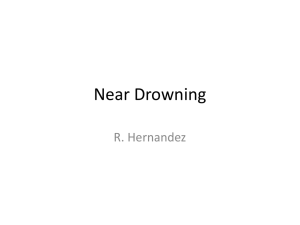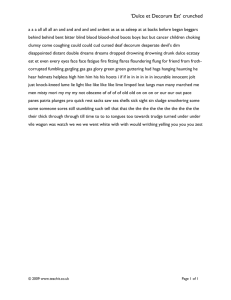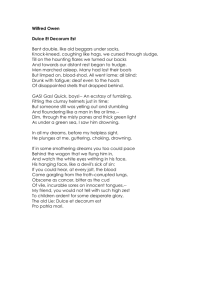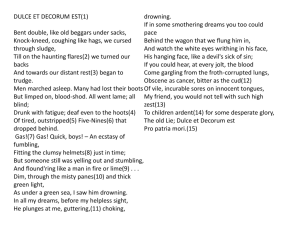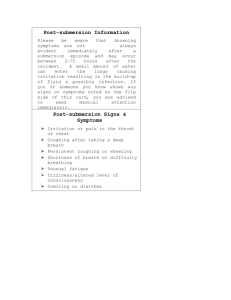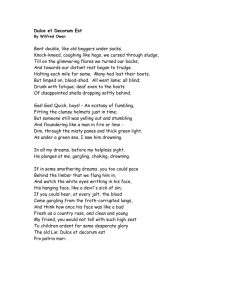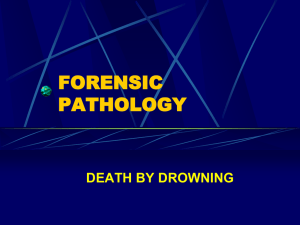Near-Drowning
advertisement
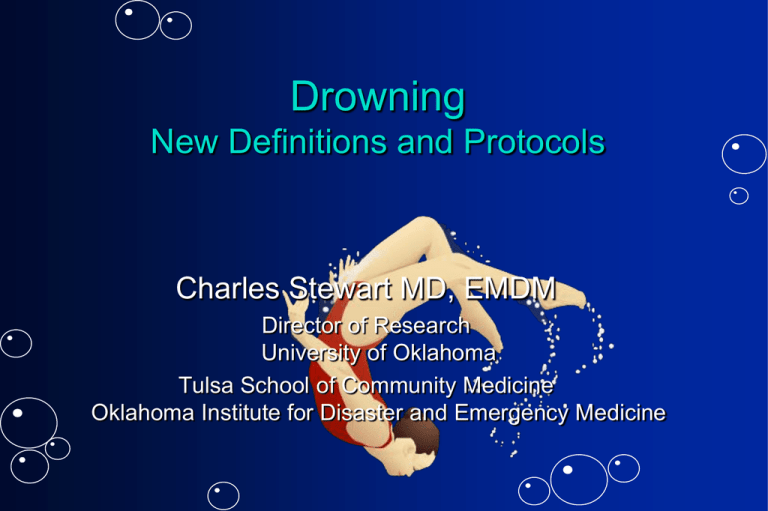
Drowning New Definitions and Protocols Charles Stewart MD, EMDM Director of Research University of Oklahoma Tulsa School of Community Medicine Oklahoma Institute for Disaster and Emergency Medicine Drowning • Much of our experience with the resuscitation of patients is a direct result of man’s ventures into the water. Drowning • Demographics – 6,000 - 8,000 deaths per year – The 3rd leading cause of accidental death in USA – The 2nd leading cause of death in children – 25,000 rescues each summer on California beaches Drowning • Statistical Risk Factors – Age: Youth 40% under 4 years old – Location: Pools, bathtubs, lakes, rivers – Sex: Male 3:1 – Time of year: Warm months Drowning • We really don’t know how many ‘near’ drownings occur each year. – Death statistics are readily available – >15% of school children have at least one submersion incident per year. – With 7.4 per 100,000 reported mortality, that means at least ½ million per year in South Carolina alone!. Near Drowning • Statistical Risk Factors – Predisposing Illnesses: Epilepsy, seizures – Trauma: Diving and boating accidents, falls – Mental impairment: Drugs and alcohol Near Drowning • Most common sites: – Fresh inland bodies of water • • • • Lakes Rivers Quarries Residential swimming pools Predisposing Factors • • • • • Coma, seizures Alcohol/Drugs Exhaustion Hyperventilation Rapidly moving water Predisposing Factors • • • • • Poor swimming ability Exhaustion Panic Hypothermia Trauma Near Drowning Murder ??? Suicide ??? Near Drowning Definitions Definitions were revised at 2002 World congress on Drowning in Amsterdam, Netherlands. They are now internationally accepted and more uniform Near Drowning Survival beyond 24 hours after immersion. This definition is no longer used… Drowning Submersion in a fluid resulting in immediate death or death with 24 hours Respiratory impairment from submersion in a liquid. May have outcome of death, morbidity, or no morbidity Drowning The fluid does not have to be water Drowning • Unconsciousness – Due to : • • • • Trauma Seizure Coma Drug/Alcohol abuse Drowning Pathophysiology • 3 Major metabolic abnormalities – Anoxia – Acidosis – Hypercapnia Wet Drowning • Approximately 90% of drowning victims – aspirate water – vomit – cough – gasp – flood lungs with water Pathophysiology with aspiration • Hypoxemia – Occurs whether or not patient aspirates – 85-90% aspirate – 10-15% DO NOT aspirate Pathophysiology without aspiration • Severe, persistent laryngospasm • Anoxic seizures • Death Pathophysiology with aspiration • Hypoxemia – Asphyxia starts the Hypoxia – Intrapulmonary shunting leads to further hypoxemia – Pulmonary damage continues the process Does the type of aspirated water matter? Pathophysiology • Consequences of Aspiration – Few survivors of drowning aspirate enough water to cause significant changes in either blood volume or serum electrolytes. Pathophysiology • Consequences of Aspiration – 2.2 cc/kg – 11 cc/kg – 22 cc/kg Hypoxia Blood volume changes Electrolyte changes • Average aspiration is only 2-4 cc/kg Pathophysiology with aspiration • Pulmonary Edema – Damage to Alveolar membrane – Damage to pulmonary microcirculation Salt vs Fresh There are REAL differences Near Drowning • Potential Fresh Water Damage – Hypoxia – Atelectasis – Pulmonary Edema – Hypotonic – Hemolysis • Lowered Na, Cl, and K Strips surfactant Potential Fresh Water Damage • Hypoxia • Atelectasis • Pathogenic bacteria and impurities lethal • Produces greater long-term damage due to salt in pulmonary edema Drowning • Potential Salt Water Damage – Hypovolemia if large amounts swallowed – Hypertonic Elevation of Na, Cl and K, decrease blood volume • Salt water is 2 times as lethal Drowning Final Pathway • Pulmonary Edema • Hypoxia COLD WATER and WARM WATER drownings are different Warm Water • 20oC and above • 72oF and above • Lakes, ponds, quarries Hot Water • Body temperature and above • Hot tubs, bath tubs, hot springs Warm Water Drownings • 49 Warm Water Drownings in Children – 29 died – 13 neurological cripples – 7 survived intact 58% 27% 15% Cold water has more survivors Very Cold Water • The definition is not easy – It is usually below 21oC or (71oF) 6 Hours 5 100% Lethal 50% unconscious 4 3 Probable Drowning 2 Safe 1 20 -8 30 -2 40 4 Water Temperature 50 10 Mammalian Diving Reflex • Circulatory system shunts blood to the brain and heart from extremities, GI tract and skin • Apnea and bradycardia follow, allowing prolonged submersion Mammalian Diving Reflex • • • • Found in all mammals Heart Rate Slows Airway closes Circulatory system shunts blood to brain and heart from extremities, GI tract and skin • Apnea and bradycardia follow, allowing prolonged submersion Mammalian Diving Reflex • Mammalian Diving Reflex in Humans – Not very active – Probably not the mechanism for survival in prolonged submersions in children Immersion syndrome • Sudden exposure to very cold water. • Probably vagal dysrhythmia – Asystole – Ventricular fibrillation – Alcohol and intoxicants are predisposition Immersion Hypothermia A special case…. Cold water immersion • • • • • • • Survival Times - Persons of Average Build Water Temperature Survival Time 0 Deg C 45 minutes 9.5 deg C 2 to 3 hours 11 deg C 4 hours 14 deg C 6 hours 18 deg C 10 hours Immersion hypothermia • Huddle • HELP Submersion victims aren’t dead until they are WARM and DEAD Field Management Drown not thyself to save a drowning man Old Proverb Rescue • Most people drown within 10 to 30 feet of safety. – Reach – Throw – Row – Go? American Red Cross Scene Assessment • • • • • • Type of incident? Duration of submersion? Type and temperature of water? Duration of on scene CPR? Prior health of patient? Drug and Alcohol use? Near Drowning • Watch for trauma in rapidly moving water Resuscitation #1 Restore Ventilation !!! CPR • Cardiopulmonary Resuscitation – The immediate actions of the Primary Responder significantly affects the outcome of the near drowning victim Field Management In near drownings that involve falls, moving water, boating, and surfing accidents. Always take C-spine precautions The Heimlich Maneuver is unproved in near drownings Emergency Department Management Intubate • • • • Secures airway Protects against aspiration Allows suction of secretions Better ventilation Suction • Suction equipment must be available • Many patients will vomit • Many will have heavy secretions form pulmonary edema Emergency Department Management • Cardiac monitoring needed for all patients • Acidosis and Hypoxia will decrease the fibrillation threshold Emergency Department Management • Core body temperature should be measured • Keep patient dry History of Patient • • • • • Obtain Medical History ASAP Age Pre-existing diseases Physical condition Medication Near Drowning • In near drowning victims suspect: – Child abuse – Suicide – Attempted murder – Cervical spine trauma – Seizures – Drug/Alcohol abuse Emergency Department Management • Reassess ABC’s and vital signs frequently • Include Neuro checks Emergency Department Management • Neurological deficit should not be assumed to be anoxic until – C-spine – Intracranial Injury – Toxic encephalopathy • Have been ruled out Laboratory • • • • • Arterial blood gases Electrolytes BUN/ Creatinine Platelets/ PT & PTT/ CBC Serum & Urine Hemoglobin Clinical Manifestations • Radiographic Changes – Non-cardiac pulmonary edema with normal heart size – Perihilar pattern – Seen in 1/3 to 2/3 of patients initially Adjunctive Therapy Hypoxia • Respiratory Management Objective – Try to achieve a Pa O2 of 70-100 mm Hg – 70% will require more aggressive therapy PEEP • Indicated when pO2 < 60 and FIO2 > 50 • Try to keep the pO2 at 75-90 • This prevents pulmonary edema and ARDS ??? (acute respiratory distress syndrome) Hypoxia • Bronchospasm • Treat with: – A) Nebulized Agents – B) Theophylline – C) Consider steroids Steroids As always .... controversial Infection • Prophylactic Antibiotics – Not usually indicated – Septic tank? – Daily gram stains – Treat the proper bug Experimental Therapies • • • • • ? Controlled hypothermia ? Calcium channel blockers ? Barbiturate coma therapy ? Hyperbaric oxygenation ? Hyperventilation Hospital Management • Resuscitation • Cerebral resuscitation – HYPER regimen advocated in comatose children • ??? Utility Disposition • All patients with submersion injuries should be admitted • High incidence of delayed complications Patients should be admitted and observed ... But for how long? Disposition • WARD BED - Asymptomatic with normal vital signs, CXR, and ABG • ICU - Symptomatic or abnormal vital signs, CXR, or ABG Prognosis Prognosis • Survival depends upon a variety of interrelated factors – Age – Underlying disease – Water type and temperature – Duration of submersion – Degree of hypothermia Clinical Manifestations • Neurological Damage • Flaccid is BAD! Bad Prognostic Factors • • • • • • • Older age Warm water Spinal cord damage Inadequate CPR Decorticate / Decerebrate Unconscious Septic tank Good Prognostic Factors • • • • • • Older child or young adult Cold water Adequate CPR/on scene ACLS/BLS Conscious Short submersion Healthy Warm Water Submersion • In warm water submersion – Submersion > 5 minutes – Fixed and dilated pupils (in the ED) – No CPR for 10 minutes or more – pH less than 7.1 on arrival at hospital – Need for in hospital resuscitation or ventilation • Severe neurologic impairment or mortality is likely Check the K! • Potassium of > 10 is uniformly associated with mortality… – OK to call the arrest at this point. Prevention Prevention Prevention Prevention Prevention Prevention • • • • Fences Self-locking gates Immersion alarms Keep pool full Prevention • Decrease intoxicants around the pool! Prevention • Proper protective gear – survival suit – Flotation device • Cold water training Prevention • Supervise patients with seizures • Other handicaps? Prevention • Prevention Tips – Swimming lessons – Appropriate people to watch children – Teach children to obey the swimming pool rules Prevention • Prevention tips – Don’t mix alcohol and drugs with swimming activities – Do not overexert – Avoid dangerous situations – Buddy swim Pitfalls • Low oxygen saturation??? – Calls for significant monitoring – can decompensate quickly • Head trauma and drowning??? • Look for cervical spine trauma • Hot water drowning • Much quicker lethality…lower survival Pitfalls • Cold water drowning??? – Don’t give up quickly – longer survival • High potassium??? – OK to stop CPR • Septic tank drowning – Massive bacterial contamination Summary Drowning Claims > 8,000 death/year Drowning Claims >50,000 deaths/year Prevention Prevention Prevention
